BSBSUS501: Policy and Procedures for Workplace Sustainability
VerifiedAdded on 2023/04/22
|48
|9105
|85
Homework Assignment
AI Summary
This document outlines the assessment criteria for BSBSUS501, which focuses on developing workplace policies and procedures for sustainability. It includes elements for competency demonstration, such as developing, communicating, implementing, and reviewing sustainability policies. The document details performance evidence, foundation skills, and knowledge evidence required for competency. It also provides assessment conditions, definitions of assessment tools, and checklists for observation and third-party assessments. The learner is expected to demonstrate competency through various activities, including workbook exercises, observations, and major activities, showing their ability to develop, communicate, implement, and review workplace sustainability policies effectively. Desklib provides a platform for students to access similar solved assignments and past papers.
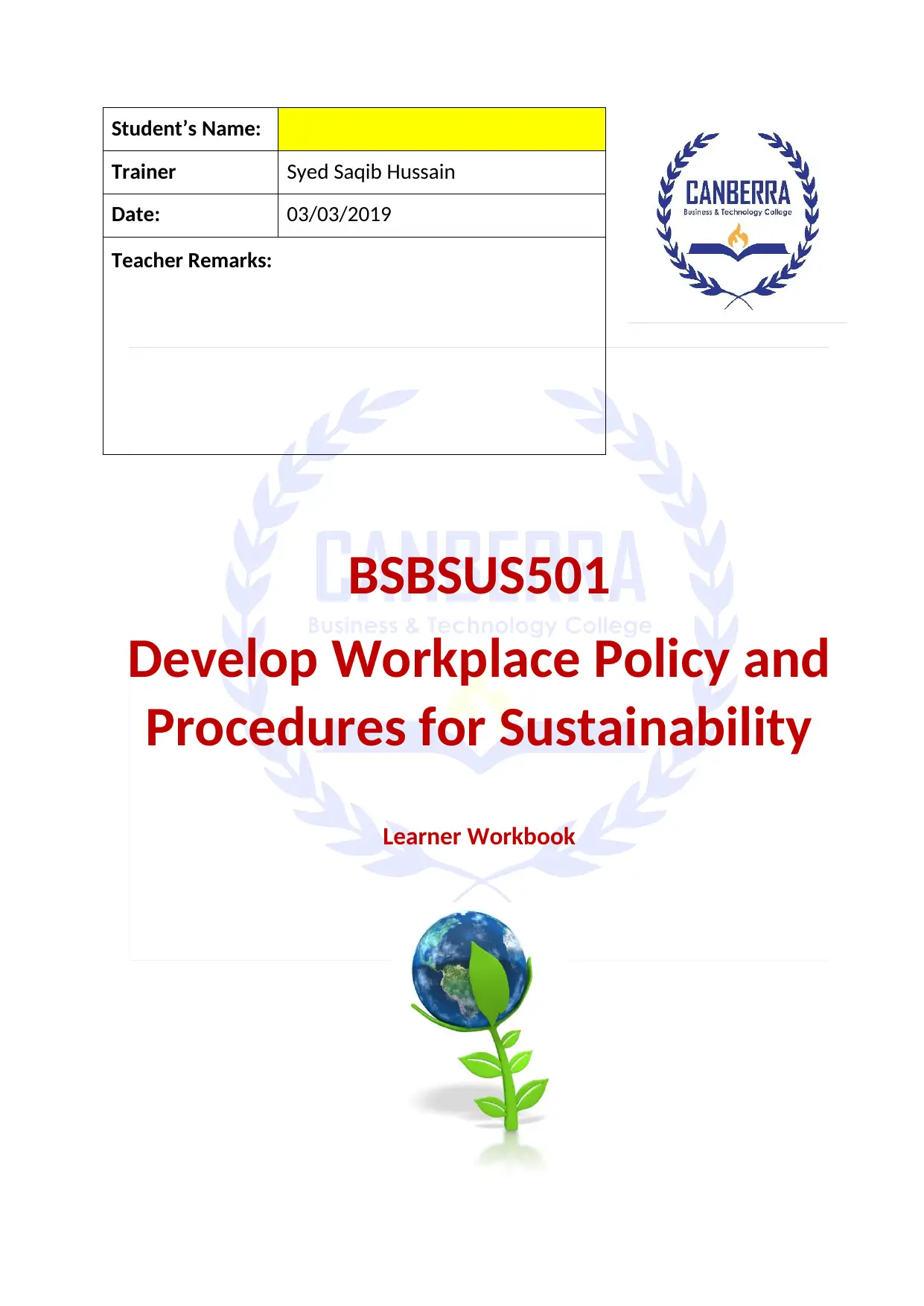
BSBSUS501
Develop Workplace Policy and
Procedures for Sustainability
Learner Workbook
Student’s Name:
Trainer Syed Saqib Hussain
Date: 03/03/2019
Teacher Remarks:
Develop Workplace Policy and
Procedures for Sustainability
Learner Workbook
Student’s Name:
Trainer Syed Saqib Hussain
Date: 03/03/2019
Teacher Remarks:
Paraphrase This Document
Need a fresh take? Get an instant paraphrase of this document with our AI Paraphraser
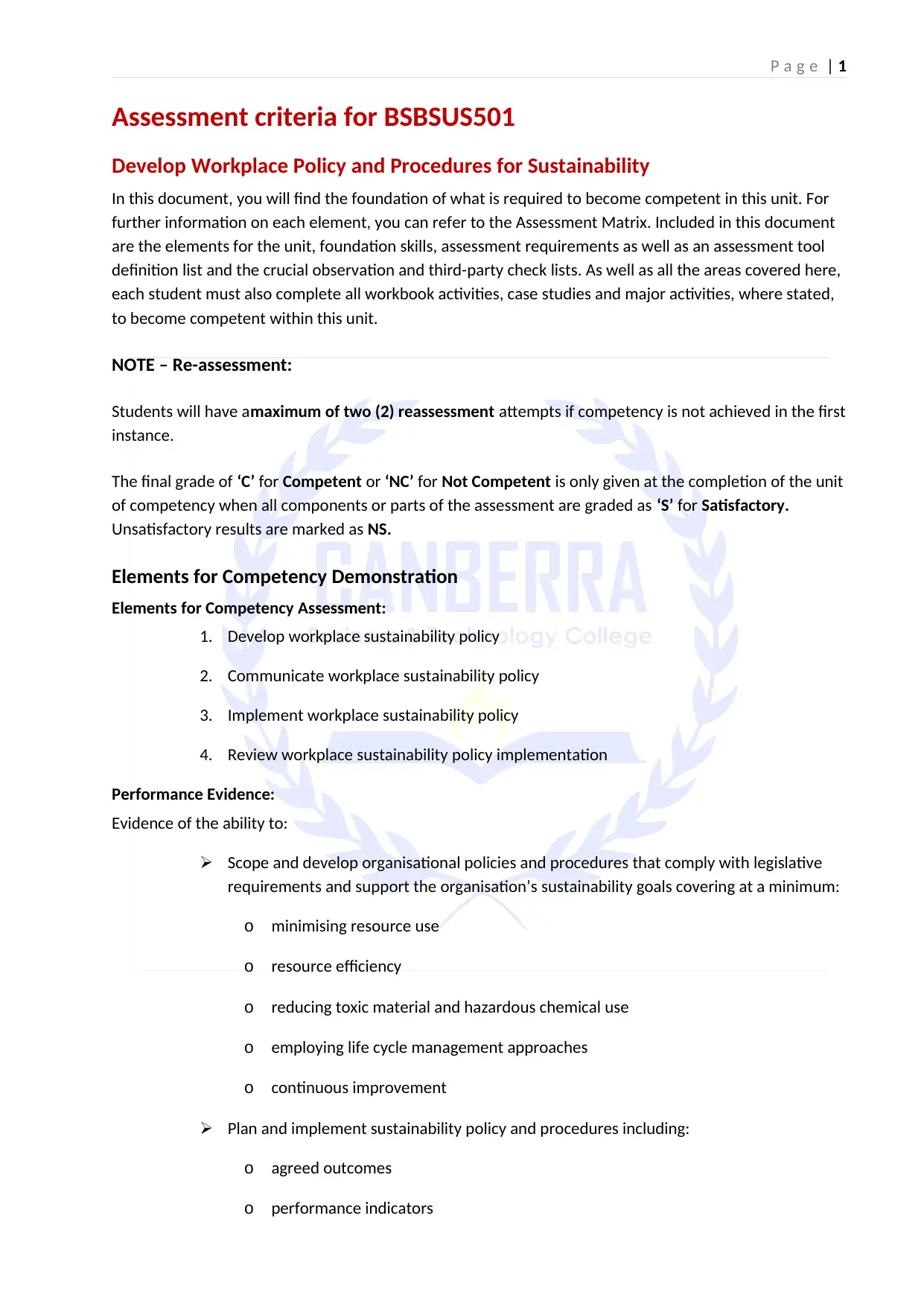
P a g e | 1
Assessment criteria for BSBSUS501
Develop Workplace Policy and Procedures for Sustainability
In this document, you will find the foundation of what is required to become competent in this unit. For
further information on each element, you can refer to the Assessment Matrix. Included in this document
are the elements for the unit, foundation skills, assessment requirements as well as an assessment tool
definition list and the crucial observation and third-party check lists. As well as all the areas covered here,
each student must also complete all workbook activities, case studies and major activities, where stated,
to become competent within this unit.
NOTE – Re-assessment:
Students will have amaximum of two (2) reassessment attempts if competency is not achieved in the first
instance.
The final grade of ‘C’ for Competent or ‘NC’ for Not Competent is only given at the completion of the unit
of competency when all components or parts of the assessment are graded as ‘S’ for Satisfactory.
Unsatisfactory results are marked as NS.
Elements for Competency Demonstration
Elements for Competency Assessment:
1. Develop workplace sustainability policy
2. Communicate workplace sustainability policy
3. Implement workplace sustainability policy
4. Review workplace sustainability policy implementation
Performance Evidence:
Evidence of the ability to:
Scope and develop organisational policies and procedures that comply with legislative
requirements and support the organisation’s sustainability goals covering at a minimum:
o minimising resource use
o resource efficiency
o reducing toxic material and hazardous chemical use
o employing life cycle management approaches
o continuous improvement
Plan and implement sustainability policy and procedures including:
o agreed outcomes
o performance indicators
Assessment criteria for BSBSUS501
Develop Workplace Policy and Procedures for Sustainability
In this document, you will find the foundation of what is required to become competent in this unit. For
further information on each element, you can refer to the Assessment Matrix. Included in this document
are the elements for the unit, foundation skills, assessment requirements as well as an assessment tool
definition list and the crucial observation and third-party check lists. As well as all the areas covered here,
each student must also complete all workbook activities, case studies and major activities, where stated,
to become competent within this unit.
NOTE – Re-assessment:
Students will have amaximum of two (2) reassessment attempts if competency is not achieved in the first
instance.
The final grade of ‘C’ for Competent or ‘NC’ for Not Competent is only given at the completion of the unit
of competency when all components or parts of the assessment are graded as ‘S’ for Satisfactory.
Unsatisfactory results are marked as NS.
Elements for Competency Demonstration
Elements for Competency Assessment:
1. Develop workplace sustainability policy
2. Communicate workplace sustainability policy
3. Implement workplace sustainability policy
4. Review workplace sustainability policy implementation
Performance Evidence:
Evidence of the ability to:
Scope and develop organisational policies and procedures that comply with legislative
requirements and support the organisation’s sustainability goals covering at a minimum:
o minimising resource use
o resource efficiency
o reducing toxic material and hazardous chemical use
o employing life cycle management approaches
o continuous improvement
Plan and implement sustainability policy and procedures including:
o agreed outcomes
o performance indicators

P a g e | 2
o activities to be undertaken
o assigned responsibilities
o record keeping, review and improvement processes
Consult and communicate with relevant stakeholders to generate engagement with
sustainability policy development, implementation and continuous improvement
Review and improve sustainability policies.
Foundation Skills:
Reading
Identifies, analyses and evaluates complex textual information to determine legislative
and regulatory requirements, trends and outcomes
Writing
Researches, plans and prepares documentation using format and language appropriate
to context, organisational requirements and audience
Oral Communication
Presents information and seeks advice using language appropriate to audience
Participates in discussions using listening and questioning to elicit the views of others
and to clarify or confirm understanding
Numeracy
Interprets and uses mathematical equations to calculate numerical information relating
to time durations and costs
Navigate the world of work
Develops, monitors and modifies organisational policies and procedures in accordance
with legislative requirements and organisation goals
Interact with others
Selects and uses appropriate conventions and protocols when communicating with
internal and external stakeholders to seek or share information
Plays a lead role in consulting and negotiating positive outcomes with a range of
stakeholders
Get the work done
Plans, organises and implements work activities of self and others that ensure
compliance with organisational policies and procedures, and legislative requirements
Sequences and schedules complex activities, monitors implementation, and manages
relevant communication
o activities to be undertaken
o assigned responsibilities
o record keeping, review and improvement processes
Consult and communicate with relevant stakeholders to generate engagement with
sustainability policy development, implementation and continuous improvement
Review and improve sustainability policies.
Foundation Skills:
Reading
Identifies, analyses and evaluates complex textual information to determine legislative
and regulatory requirements, trends and outcomes
Writing
Researches, plans and prepares documentation using format and language appropriate
to context, organisational requirements and audience
Oral Communication
Presents information and seeks advice using language appropriate to audience
Participates in discussions using listening and questioning to elicit the views of others
and to clarify or confirm understanding
Numeracy
Interprets and uses mathematical equations to calculate numerical information relating
to time durations and costs
Navigate the world of work
Develops, monitors and modifies organisational policies and procedures in accordance
with legislative requirements and organisation goals
Interact with others
Selects and uses appropriate conventions and protocols when communicating with
internal and external stakeholders to seek or share information
Plays a lead role in consulting and negotiating positive outcomes with a range of
stakeholders
Get the work done
Plans, organises and implements work activities of self and others that ensure
compliance with organisational policies and procedures, and legislative requirements
Sequences and schedules complex activities, monitors implementation, and manages
relevant communication
⊘ This is a preview!⊘
Do you want full access?
Subscribe today to unlock all pages.

Trusted by 1+ million students worldwide

P a g e | 3
Uses systematic, analytical processes in relatively complex, situations, setting goals,
gathering relevant information, and identifying and evaluating options against agreed
criteria
Evaluates outcomes of decisions to identify opportunities for improvement
Knowledge Evidence:
To complete the unit requirements safely and effectively, the individual must:
Outline the environmental or sustainability legislation, regulations and codes of practice
applicable to the organisation identify internal and external sources of information and
explain how they can be used to plan and develop the organisation’s sustainability policy
Explain policy development processes and practices
Outline organisational systems and procedures that relate to sustainability
Outline typical barriers to implementing policies and procedures in an organisation and
possible strategies to address them.
Assessment Conditions:
Assessment must be conducted in a safe environment where evidence gathered demonstrates consistent
performance of typical activities experienced in the sustainability field of work and include access to:
Relevant legislation, regulations, standards and codes
Relevant workplace documentation and resources
Case studies and, where possible, real situations
Interaction with others.
Assessors must satisfy NVR/AQTF assessor requirements.
Links:
Companion volumes available from the IBSA website: http://www.ibsa.org.au/companion_volumes -
http://www.ibsa.org.au/companion_volumes
Any observations and practical assessments must be recorded in the observation checklist. All practical
tasks should be demonstrated during the length of the course. As the instructor, you must maintain a
record demonstrating the date of the practical activities and any comments relevant to the performance
of each student. Where a student is not able to demonstrate competence in a practical observation
activity, further questioning should be put in its place.
As the instructor, you could be assessing the student’s literacy, numeracy and language skills, as well as
the content and context of his/her answers.
In some cases, you will have to adjust and amend the assessment tools, using different and varied
methods (such as oral assessment), to allow students to be assessed according to their needs and
abilities.
Uses systematic, analytical processes in relatively complex, situations, setting goals,
gathering relevant information, and identifying and evaluating options against agreed
criteria
Evaluates outcomes of decisions to identify opportunities for improvement
Knowledge Evidence:
To complete the unit requirements safely and effectively, the individual must:
Outline the environmental or sustainability legislation, regulations and codes of practice
applicable to the organisation identify internal and external sources of information and
explain how they can be used to plan and develop the organisation’s sustainability policy
Explain policy development processes and practices
Outline organisational systems and procedures that relate to sustainability
Outline typical barriers to implementing policies and procedures in an organisation and
possible strategies to address them.
Assessment Conditions:
Assessment must be conducted in a safe environment where evidence gathered demonstrates consistent
performance of typical activities experienced in the sustainability field of work and include access to:
Relevant legislation, regulations, standards and codes
Relevant workplace documentation and resources
Case studies and, where possible, real situations
Interaction with others.
Assessors must satisfy NVR/AQTF assessor requirements.
Links:
Companion volumes available from the IBSA website: http://www.ibsa.org.au/companion_volumes -
http://www.ibsa.org.au/companion_volumes
Any observations and practical assessments must be recorded in the observation checklist. All practical
tasks should be demonstrated during the length of the course. As the instructor, you must maintain a
record demonstrating the date of the practical activities and any comments relevant to the performance
of each student. Where a student is not able to demonstrate competence in a practical observation
activity, further questioning should be put in its place.
As the instructor, you could be assessing the student’s literacy, numeracy and language skills, as well as
the content and context of his/her answers.
In some cases, you will have to adjust and amend the assessment tools, using different and varied
methods (such as oral assessment), to allow students to be assessed according to their needs and
abilities.
Paraphrase This Document
Need a fresh take? Get an instant paraphrase of this document with our AI Paraphraser
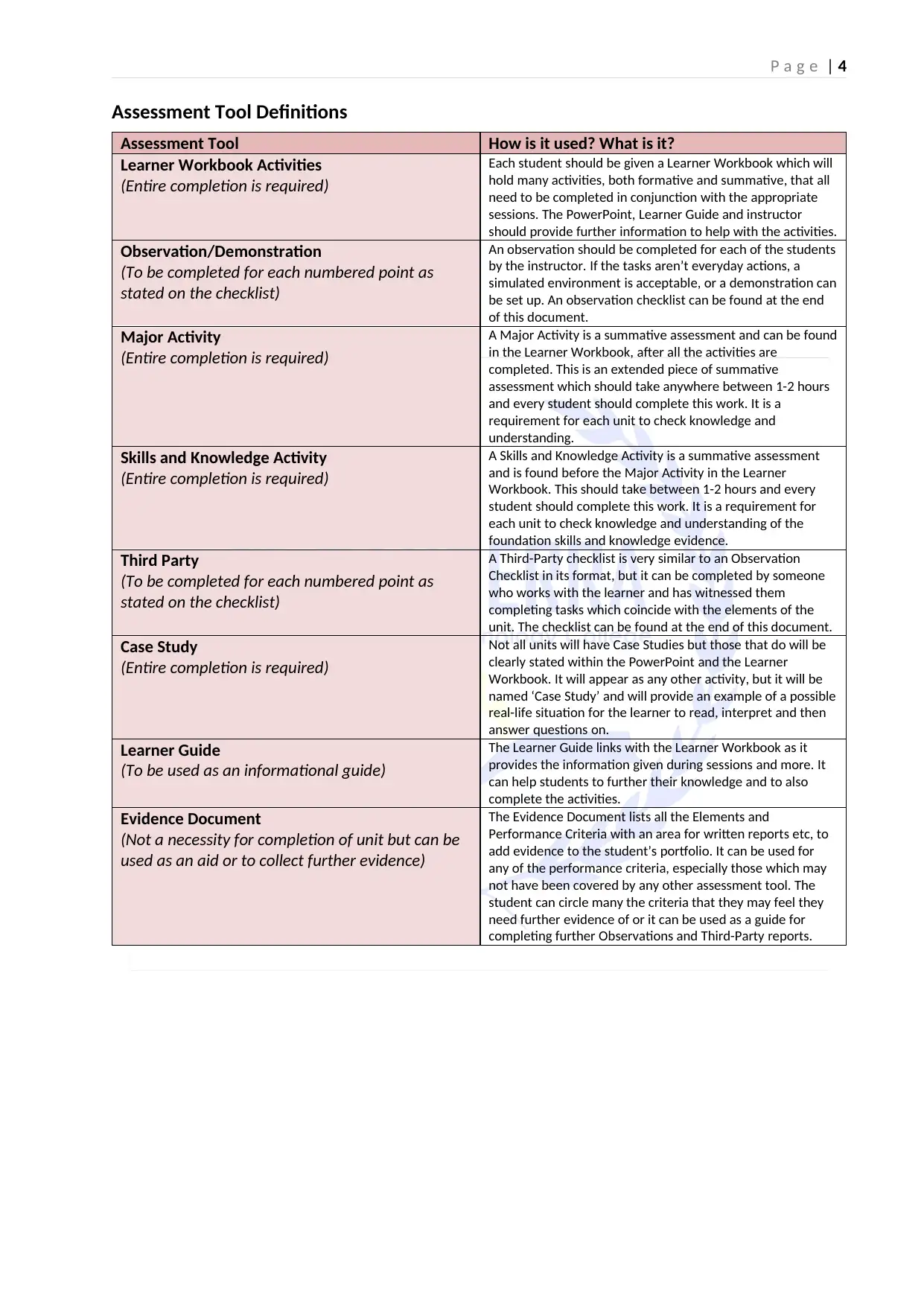
P a g e | 4
Assessment Tool Definitions
Assessment Tool How is it used? What is it?
Learner Workbook Activities
(Entire completion is required)
Each student should be given a Learner Workbook which will
hold many activities, both formative and summative, that all
need to be completed in conjunction with the appropriate
sessions. The PowerPoint, Learner Guide and instructor
should provide further information to help with the activities.
Observation/Demonstration
(To be completed for each numbered point as
stated on the checklist)
An observation should be completed for each of the students
by the instructor. If the tasks aren’t everyday actions, a
simulated environment is acceptable, or a demonstration can
be set up. An observation checklist can be found at the end
of this document.
Major Activity
(Entire completion is required)
A Major Activity is a summative assessment and can be found
in the Learner Workbook, after all the activities are
completed. This is an extended piece of summative
assessment which should take anywhere between 1-2 hours
and every student should complete this work. It is a
requirement for each unit to check knowledge and
understanding.
Skills and Knowledge Activity
(Entire completion is required)
A Skills and Knowledge Activity is a summative assessment
and is found before the Major Activity in the Learner
Workbook. This should take between 1-2 hours and every
student should complete this work. It is a requirement for
each unit to check knowledge and understanding of the
foundation skills and knowledge evidence.
Third Party
(To be completed for each numbered point as
stated on the checklist)
A Third-Party checklist is very similar to an Observation
Checklist in its format, but it can be completed by someone
who works with the learner and has witnessed them
completing tasks which coincide with the elements of the
unit. The checklist can be found at the end of this document.
Case Study
(Entire completion is required)
Not all units will have Case Studies but those that do will be
clearly stated within the PowerPoint and the Learner
Workbook. It will appear as any other activity, but it will be
named ‘Case Study’ and will provide an example of a possible
real-life situation for the learner to read, interpret and then
answer questions on.
Learner Guide
(To be used as an informational guide)
The Learner Guide links with the Learner Workbook as it
provides the information given during sessions and more. It
can help students to further their knowledge and to also
complete the activities.
Evidence Document
(Not a necessity for completion of unit but can be
used as an aid or to collect further evidence)
The Evidence Document lists all the Elements and
Performance Criteria with an area for written reports etc, to
add evidence to the student’s portfolio. It can be used for
any of the performance criteria, especially those which may
not have been covered by any other assessment tool. The
student can circle many the criteria that they may feel they
need further evidence of or it can be used as a guide for
completing further Observations and Third-Party reports.
Assessment Tool Definitions
Assessment Tool How is it used? What is it?
Learner Workbook Activities
(Entire completion is required)
Each student should be given a Learner Workbook which will
hold many activities, both formative and summative, that all
need to be completed in conjunction with the appropriate
sessions. The PowerPoint, Learner Guide and instructor
should provide further information to help with the activities.
Observation/Demonstration
(To be completed for each numbered point as
stated on the checklist)
An observation should be completed for each of the students
by the instructor. If the tasks aren’t everyday actions, a
simulated environment is acceptable, or a demonstration can
be set up. An observation checklist can be found at the end
of this document.
Major Activity
(Entire completion is required)
A Major Activity is a summative assessment and can be found
in the Learner Workbook, after all the activities are
completed. This is an extended piece of summative
assessment which should take anywhere between 1-2 hours
and every student should complete this work. It is a
requirement for each unit to check knowledge and
understanding.
Skills and Knowledge Activity
(Entire completion is required)
A Skills and Knowledge Activity is a summative assessment
and is found before the Major Activity in the Learner
Workbook. This should take between 1-2 hours and every
student should complete this work. It is a requirement for
each unit to check knowledge and understanding of the
foundation skills and knowledge evidence.
Third Party
(To be completed for each numbered point as
stated on the checklist)
A Third-Party checklist is very similar to an Observation
Checklist in its format, but it can be completed by someone
who works with the learner and has witnessed them
completing tasks which coincide with the elements of the
unit. The checklist can be found at the end of this document.
Case Study
(Entire completion is required)
Not all units will have Case Studies but those that do will be
clearly stated within the PowerPoint and the Learner
Workbook. It will appear as any other activity, but it will be
named ‘Case Study’ and will provide an example of a possible
real-life situation for the learner to read, interpret and then
answer questions on.
Learner Guide
(To be used as an informational guide)
The Learner Guide links with the Learner Workbook as it
provides the information given during sessions and more. It
can help students to further their knowledge and to also
complete the activities.
Evidence Document
(Not a necessity for completion of unit but can be
used as an aid or to collect further evidence)
The Evidence Document lists all the Elements and
Performance Criteria with an area for written reports etc, to
add evidence to the student’s portfolio. It can be used for
any of the performance criteria, especially those which may
not have been covered by any other assessment tool. The
student can circle many the criteria that they may feel they
need further evidence of or it can be used as a guide for
completing further Observations and Third-Party reports.
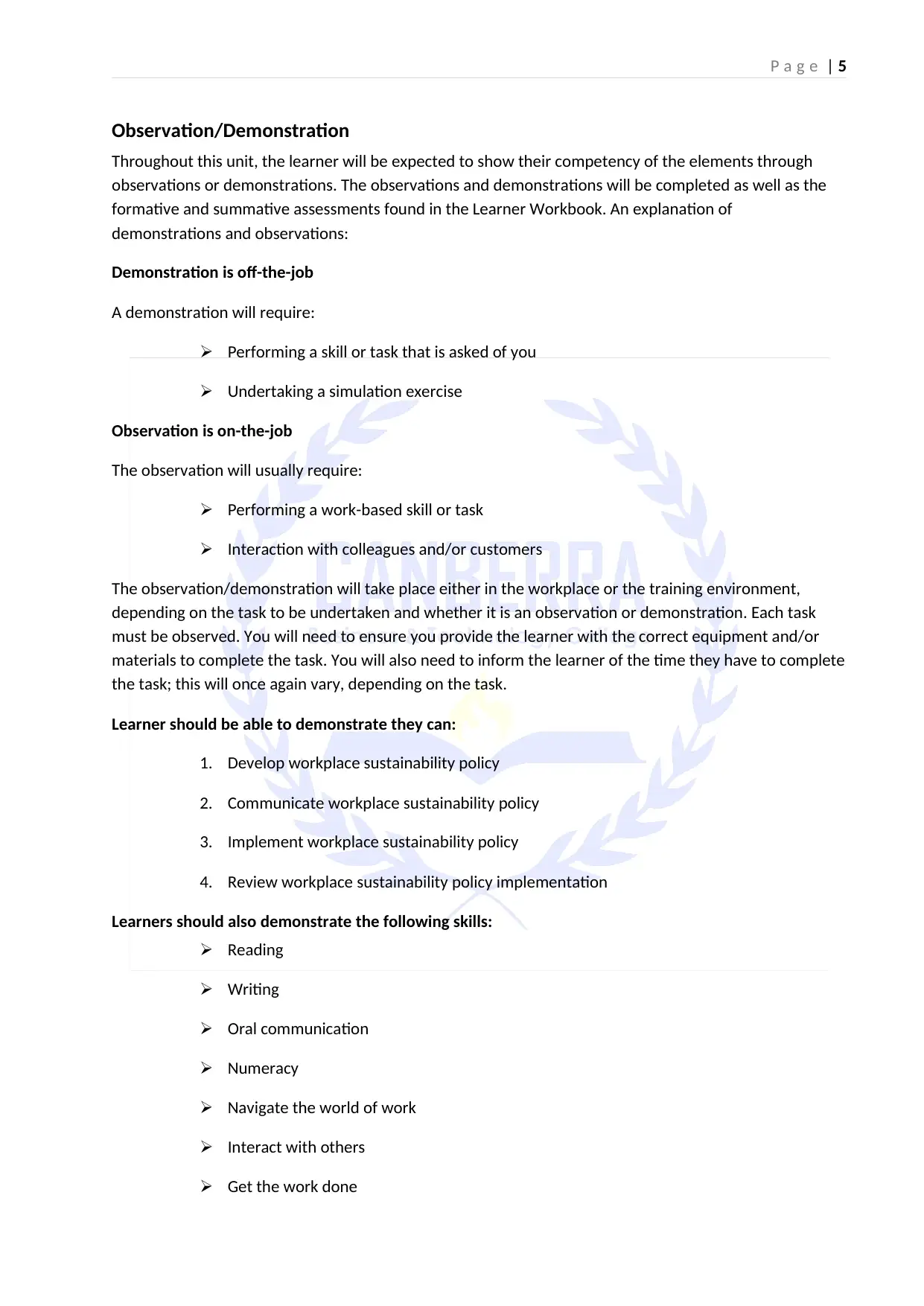
P a g e | 5
Observation/Demonstration
Throughout this unit, the learner will be expected to show their competency of the elements through
observations or demonstrations. The observations and demonstrations will be completed as well as the
formative and summative assessments found in the Learner Workbook. An explanation of
demonstrations and observations:
Demonstration is off-the-job
A demonstration will require:
Performing a skill or task that is asked of you
Undertaking a simulation exercise
Observation is on-the-job
The observation will usually require:
Performing a work-based skill or task
Interaction with colleagues and/or customers
The observation/demonstration will take place either in the workplace or the training environment,
depending on the task to be undertaken and whether it is an observation or demonstration. Each task
must be observed. You will need to ensure you provide the learner with the correct equipment and/or
materials to complete the task. You will also need to inform the learner of the time they have to complete
the task; this will once again vary, depending on the task.
Learner should be able to demonstrate they can:
1. Develop workplace sustainability policy
2. Communicate workplace sustainability policy
3. Implement workplace sustainability policy
4. Review workplace sustainability policy implementation
Learners should also demonstrate the following skills:
Reading
Writing
Oral communication
Numeracy
Navigate the world of work
Interact with others
Get the work done
Observation/Demonstration
Throughout this unit, the learner will be expected to show their competency of the elements through
observations or demonstrations. The observations and demonstrations will be completed as well as the
formative and summative assessments found in the Learner Workbook. An explanation of
demonstrations and observations:
Demonstration is off-the-job
A demonstration will require:
Performing a skill or task that is asked of you
Undertaking a simulation exercise
Observation is on-the-job
The observation will usually require:
Performing a work-based skill or task
Interaction with colleagues and/or customers
The observation/demonstration will take place either in the workplace or the training environment,
depending on the task to be undertaken and whether it is an observation or demonstration. Each task
must be observed. You will need to ensure you provide the learner with the correct equipment and/or
materials to complete the task. You will also need to inform the learner of the time they have to complete
the task; this will once again vary, depending on the task.
Learner should be able to demonstrate they can:
1. Develop workplace sustainability policy
2. Communicate workplace sustainability policy
3. Implement workplace sustainability policy
4. Review workplace sustainability policy implementation
Learners should also demonstrate the following skills:
Reading
Writing
Oral communication
Numeracy
Navigate the world of work
Interact with others
Get the work done
⊘ This is a preview!⊘
Do you want full access?
Subscribe today to unlock all pages.

Trusted by 1+ million students worldwide

P a g e | 6
Observation/Demonstration Checklist
Candidate’s Name
Assessor or Observer’s Name Syed Saqib Hussain
Unit of Competence
(Code and Title) BSBSUS 501 Develop Workplace Policy and Procedures for
Sustainability
Date of Assessment 03/03/2019
Location 75 Gozzard Street, Gungahlin ACT 2912, Australia
Demonstration Tasks Completed
Materials and Equipment Provided
Tasks to be observed, demonstrated or simulated
if appropriate
Yes No Comment
1. Develop workplace sustainability policy:
Did the learner demonstrate that they could
define scope of sustainability policy?
2. Develop workplace sustainability policy:
Did the learner demonstrate that they could
gather information from a range of sources to
plan and develop policy?
3. Develop workplace sustainability policy:
Did the learner demonstrate that they could
identify and consult stakeholders as a key
component of the policy development
process?
4. Develop workplace sustainability policy:
Did the learner demonstrate that they could
include appropriate strategies in policy at all
stages of work for minimizing resource use,
reducing toxic material and hazardous
chemical use and employing life cycle
management approaches?
5. Develop workplace sustainability policy:
Did the learner demonstrate that they could
make recommendations for policy options
based on likely effectiveness, timeframes and
cost?
6. Develop workplace sustainability policy:
Did the learner demonstrate that they could
develop policy that reflects the organization's
commitment to sustainability as an integral
part of business planning and as a business
opportunity?
Observation/Demonstration Checklist
Candidate’s Name
Assessor or Observer’s Name Syed Saqib Hussain
Unit of Competence
(Code and Title) BSBSUS 501 Develop Workplace Policy and Procedures for
Sustainability
Date of Assessment 03/03/2019
Location 75 Gozzard Street, Gungahlin ACT 2912, Australia
Demonstration Tasks Completed
Materials and Equipment Provided
Tasks to be observed, demonstrated or simulated
if appropriate
Yes No Comment
1. Develop workplace sustainability policy:
Did the learner demonstrate that they could
define scope of sustainability policy?
2. Develop workplace sustainability policy:
Did the learner demonstrate that they could
gather information from a range of sources to
plan and develop policy?
3. Develop workplace sustainability policy:
Did the learner demonstrate that they could
identify and consult stakeholders as a key
component of the policy development
process?
4. Develop workplace sustainability policy:
Did the learner demonstrate that they could
include appropriate strategies in policy at all
stages of work for minimizing resource use,
reducing toxic material and hazardous
chemical use and employing life cycle
management approaches?
5. Develop workplace sustainability policy:
Did the learner demonstrate that they could
make recommendations for policy options
based on likely effectiveness, timeframes and
cost?
6. Develop workplace sustainability policy:
Did the learner demonstrate that they could
develop policy that reflects the organization's
commitment to sustainability as an integral
part of business planning and as a business
opportunity?
Paraphrase This Document
Need a fresh take? Get an instant paraphrase of this document with our AI Paraphraser
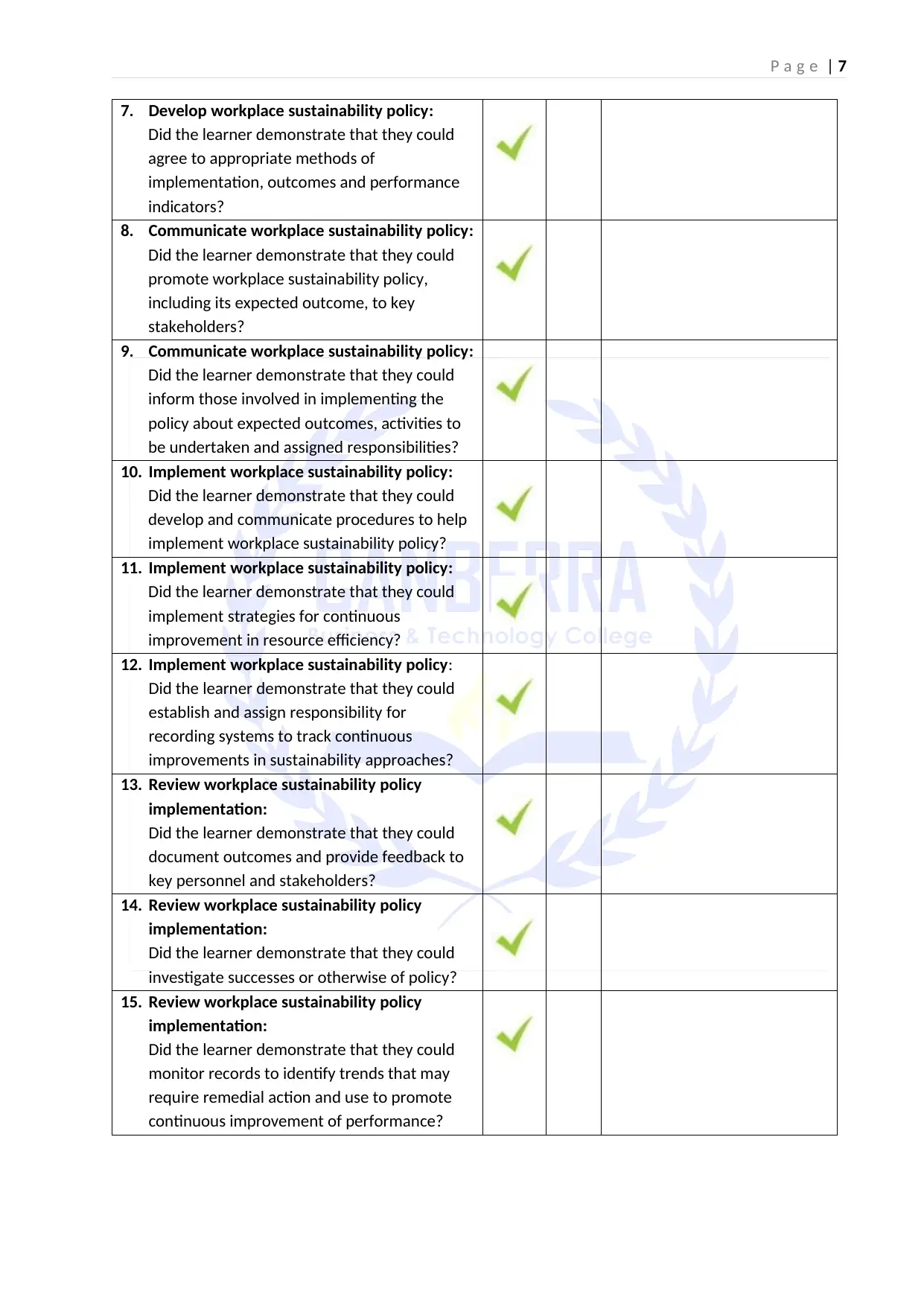
P a g e | 7
7. Develop workplace sustainability policy:
Did the learner demonstrate that they could
agree to appropriate methods of
implementation, outcomes and performance
indicators?
8. Communicate workplace sustainability policy:
Did the learner demonstrate that they could
promote workplace sustainability policy,
including its expected outcome, to key
stakeholders?
9. Communicate workplace sustainability policy:
Did the learner demonstrate that they could
inform those involved in implementing the
policy about expected outcomes, activities to
be undertaken and assigned responsibilities?
10. Implement workplace sustainability policy:
Did the learner demonstrate that they could
develop and communicate procedures to help
implement workplace sustainability policy?
11. Implement workplace sustainability policy:
Did the learner demonstrate that they could
implement strategies for continuous
improvement in resource efficiency?
12. Implement workplace sustainability policy:
Did the learner demonstrate that they could
establish and assign responsibility for
recording systems to track continuous
improvements in sustainability approaches?
13. Review workplace sustainability policy
implementation:
Did the learner demonstrate that they could
document outcomes and provide feedback to
key personnel and stakeholders?
14. Review workplace sustainability policy
implementation:
Did the learner demonstrate that they could
investigate successes or otherwise of policy?
15. Review workplace sustainability policy
implementation:
Did the learner demonstrate that they could
monitor records to identify trends that may
require remedial action and use to promote
continuous improvement of performance?
7. Develop workplace sustainability policy:
Did the learner demonstrate that they could
agree to appropriate methods of
implementation, outcomes and performance
indicators?
8. Communicate workplace sustainability policy:
Did the learner demonstrate that they could
promote workplace sustainability policy,
including its expected outcome, to key
stakeholders?
9. Communicate workplace sustainability policy:
Did the learner demonstrate that they could
inform those involved in implementing the
policy about expected outcomes, activities to
be undertaken and assigned responsibilities?
10. Implement workplace sustainability policy:
Did the learner demonstrate that they could
develop and communicate procedures to help
implement workplace sustainability policy?
11. Implement workplace sustainability policy:
Did the learner demonstrate that they could
implement strategies for continuous
improvement in resource efficiency?
12. Implement workplace sustainability policy:
Did the learner demonstrate that they could
establish and assign responsibility for
recording systems to track continuous
improvements in sustainability approaches?
13. Review workplace sustainability policy
implementation:
Did the learner demonstrate that they could
document outcomes and provide feedback to
key personnel and stakeholders?
14. Review workplace sustainability policy
implementation:
Did the learner demonstrate that they could
investigate successes or otherwise of policy?
15. Review workplace sustainability policy
implementation:
Did the learner demonstrate that they could
monitor records to identify trends that may
require remedial action and use to promote
continuous improvement of performance?

P a g e | 8
16. Review workplace sustainability policy
implementation:
Did the learner demonstrate that they could
modify policy and or procedures as required to
ensure improvements are made?
The candidate’s
performance was:
Not Satisfactory Satisfactory
Further Comments:
Candidate’s Signature
Assessor/Observer’s
Signature
Syed Saqib Hussain
16. Review workplace sustainability policy
implementation:
Did the learner demonstrate that they could
modify policy and or procedures as required to
ensure improvements are made?
The candidate’s
performance was:
Not Satisfactory Satisfactory
Further Comments:
Candidate’s Signature
Assessor/Observer’s
Signature
Syed Saqib Hussain
⊘ This is a preview!⊘
Do you want full access?
Subscribe today to unlock all pages.

Trusted by 1+ million students worldwide
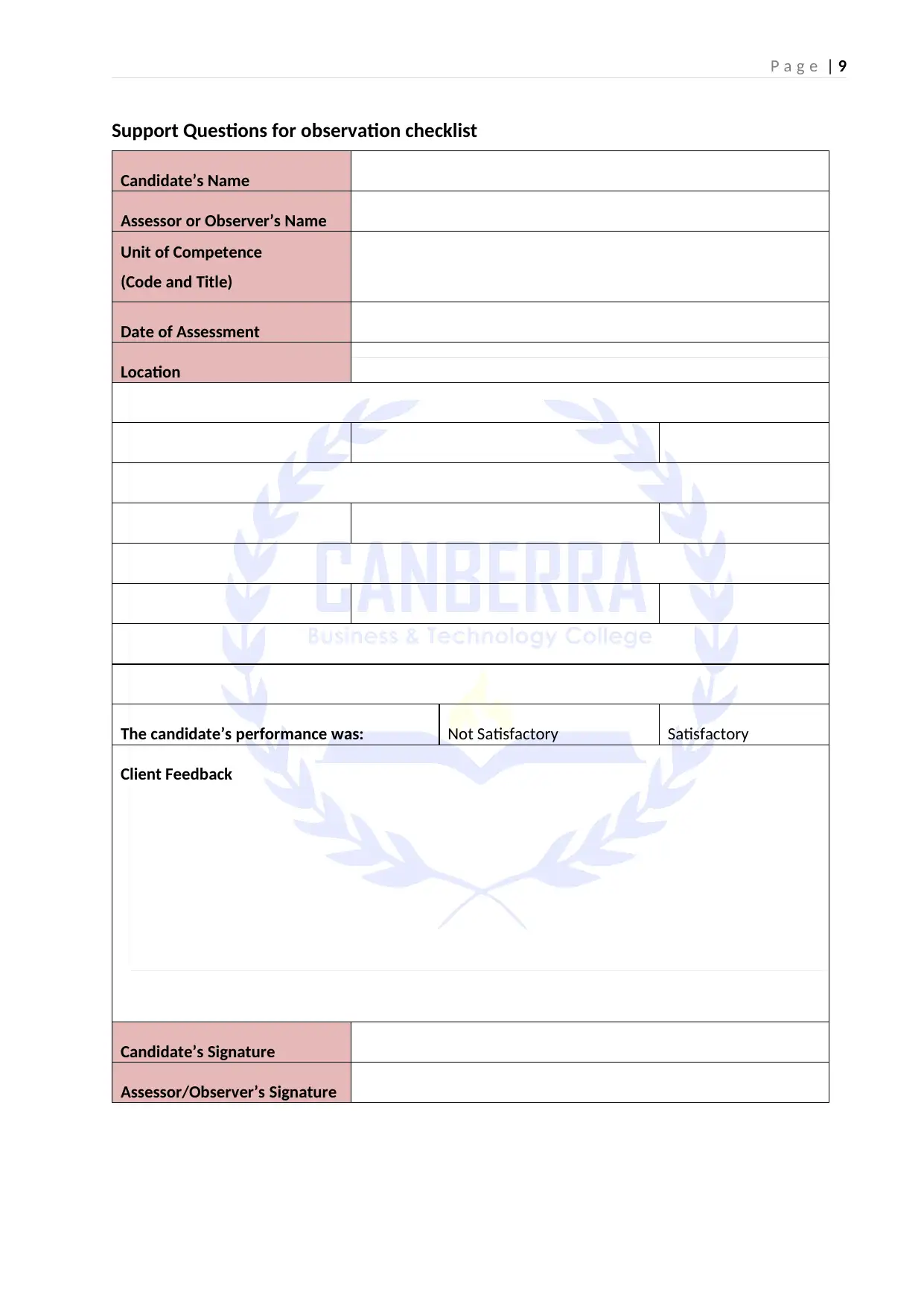
P a g e | 9
Support Questions for observation checklist
Candidate’s Name
Assessor or Observer’s Name
Unit of Competence
(Code and Title)
Date of Assessment
Location
The candidate’s performance was: Not Satisfactory Satisfactory
Client Feedback
Candidate’s Signature
Assessor/Observer’s Signature
Support Questions for observation checklist
Candidate’s Name
Assessor or Observer’s Name
Unit of Competence
(Code and Title)
Date of Assessment
Location
The candidate’s performance was: Not Satisfactory Satisfactory
Client Feedback
Candidate’s Signature
Assessor/Observer’s Signature
Paraphrase This Document
Need a fresh take? Get an instant paraphrase of this document with our AI Paraphraser

P a g e | 10
Third Party Reports
The Third-Party Report should be completed by a senior member of staff i.e. a supervisor or manager,
where possible. The report should cover the points below, with a description to show that the tasks have
been witnessed over time, while working with the learner. Examples, times, dates etc. should be
included, if possible.
As this unit is about developing workplace policy and procedures for sustainability, you will need to have
witnessed the learner within a working or training environment:
Developing workplace sustainability policy
Communicating workplace sustainability policy
Implementing workplace sustainability policy
Reviewing workplace sustainability policy implementation
Ticking yes/no next to the tasks is required, as well as an accompanying report.
Third Party Reports
The Third-Party Report should be completed by a senior member of staff i.e. a supervisor or manager,
where possible. The report should cover the points below, with a description to show that the tasks have
been witnessed over time, while working with the learner. Examples, times, dates etc. should be
included, if possible.
As this unit is about developing workplace policy and procedures for sustainability, you will need to have
witnessed the learner within a working or training environment:
Developing workplace sustainability policy
Communicating workplace sustainability policy
Implementing workplace sustainability policy
Reviewing workplace sustainability policy implementation
Ticking yes/no next to the tasks is required, as well as an accompanying report.
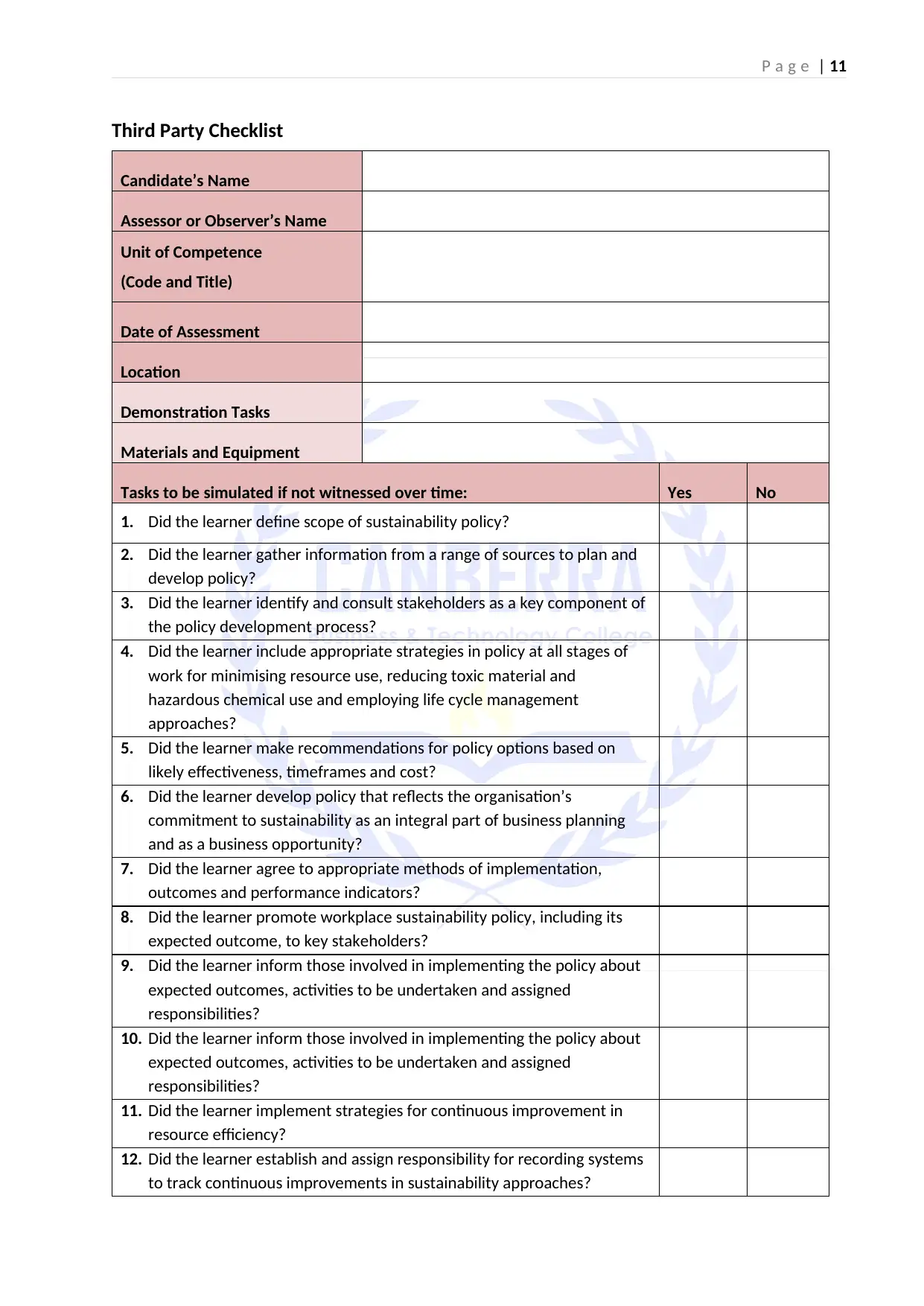
P a g e | 11
Third Party Checklist
Candidate’s Name
Assessor or Observer’s Name
Unit of Competence
(Code and Title)
Date of Assessment
Location
Demonstration Tasks
Materials and Equipment
Tasks to be simulated if not witnessed over time: Yes No
1. Did the learner define scope of sustainability policy?
2. Did the learner gather information from a range of sources to plan and
develop policy?
3. Did the learner identify and consult stakeholders as a key component of
the policy development process?
4. Did the learner include appropriate strategies in policy at all stages of
work for minimising resource use, reducing toxic material and
hazardous chemical use and employing life cycle management
approaches?
5. Did the learner make recommendations for policy options based on
likely effectiveness, timeframes and cost?
6. Did the learner develop policy that reflects the organisation’s
commitment to sustainability as an integral part of business planning
and as a business opportunity?
7. Did the learner agree to appropriate methods of implementation,
outcomes and performance indicators?
8. Did the learner promote workplace sustainability policy, including its
expected outcome, to key stakeholders?
9. Did the learner inform those involved in implementing the policy about
expected outcomes, activities to be undertaken and assigned
responsibilities?
10. Did the learner inform those involved in implementing the policy about
expected outcomes, activities to be undertaken and assigned
responsibilities?
11. Did the learner implement strategies for continuous improvement in
resource efficiency?
12. Did the learner establish and assign responsibility for recording systems
to track continuous improvements in sustainability approaches?
Third Party Checklist
Candidate’s Name
Assessor or Observer’s Name
Unit of Competence
(Code and Title)
Date of Assessment
Location
Demonstration Tasks
Materials and Equipment
Tasks to be simulated if not witnessed over time: Yes No
1. Did the learner define scope of sustainability policy?
2. Did the learner gather information from a range of sources to plan and
develop policy?
3. Did the learner identify and consult stakeholders as a key component of
the policy development process?
4. Did the learner include appropriate strategies in policy at all stages of
work for minimising resource use, reducing toxic material and
hazardous chemical use and employing life cycle management
approaches?
5. Did the learner make recommendations for policy options based on
likely effectiveness, timeframes and cost?
6. Did the learner develop policy that reflects the organisation’s
commitment to sustainability as an integral part of business planning
and as a business opportunity?
7. Did the learner agree to appropriate methods of implementation,
outcomes and performance indicators?
8. Did the learner promote workplace sustainability policy, including its
expected outcome, to key stakeholders?
9. Did the learner inform those involved in implementing the policy about
expected outcomes, activities to be undertaken and assigned
responsibilities?
10. Did the learner inform those involved in implementing the policy about
expected outcomes, activities to be undertaken and assigned
responsibilities?
11. Did the learner implement strategies for continuous improvement in
resource efficiency?
12. Did the learner establish and assign responsibility for recording systems
to track continuous improvements in sustainability approaches?
⊘ This is a preview!⊘
Do you want full access?
Subscribe today to unlock all pages.

Trusted by 1+ million students worldwide
1 out of 48
Related Documents
Your All-in-One AI-Powered Toolkit for Academic Success.
+13062052269
info@desklib.com
Available 24*7 on WhatsApp / Email
![[object Object]](/_next/static/media/star-bottom.7253800d.svg)
Unlock your academic potential
Copyright © 2020–2025 A2Z Services. All Rights Reserved. Developed and managed by ZUCOL.





